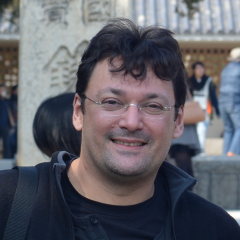And the Emmy Award Goes to … Professor Claudio Silva
Silva Receives Emmy Award for His MLB Visual Analytics Tool

Professor Silva's visual analytics tool provides the ability to analyze each and every play on the baseball field.
There may not have been a red carpet involved, but Professor of Computer Science and Engineering Claudio Silva had cause for celebration when the National Academy of Television Arts & Sciences (NATAS) announced the winners of the 2018 Technology and Engineering Emmy Awards, which honor breakthroughs in technology that have a significant effect on television engineering.
Silva is the developer of a visual analytics tool now being used in Major League Baseball (MLB) stadiums across the country as part of the Emmy-winning Statcast, which combines the tool with a radar-based ball-tracking system and an optical player-tracking solution.

Professor Claudio Silva
Silva’s tool — which he dubbed Baseball 4D when he presented it at the 2014 Institute of Electrical and Electronics Engineers Visualization Conference — provided the ability to analyze each and every play on the field for the first time in sports history, allowing fans and industry officials to answer previously unanswerable analytics questions like where players should be positioned to best catch a ball traveling at a particular velocity or which players were most likely to accurately anticipate a pitch’s trajectory.
Silva collaborated with MLB Advanced Media on the development of the system — which involves groups of high-performance cameras installed throughout the ballpark along with software that produces highly interactive visualizations of the game in unprecedented detail. MLB Advanced Media shares the Emmy, which will be presented on April 8th, 2018 at a ceremony in Las Vegas, with the company ChyronHego, which was responsible for Statcast’s optical player-tracking equipment, and TrackMan, the creators of its radar-based ball-tracking system.
The Emmy win was not the only time in recent weeks that Silva had made a splash in the media. In Rio to visit the Fundação Getúlio Vargas, a well-regarded institution of higher learning, he was interviewed about machine learning and data visualization by the Brazilian publication O Globo.
While the Emmy may recognize the significance of visual analytics in sports, his research into data visualization has far-reaching applications and potentials, from building software in smart cars to creating interactive urban design models.




